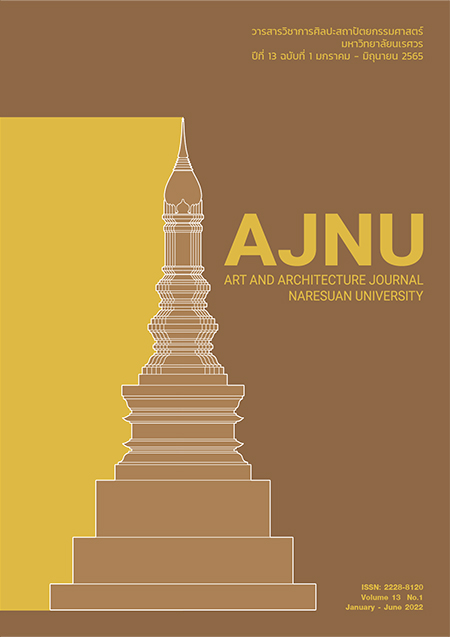The Creation of the Old Town Trat’s Tourism Map
Main Article Content
Abstract
In the past, the old town of Trat was a business district, and the main transportation route was Bang Phra Canal for exporting goods to Trat River. In recent times, Trat municipal has established the community situated along Bang Phra Canal to be "Rak Klong Bang Phra Community". The community has well-preserved architecture. The objective of this study was to create a map for tourists to walk or cycling along the route in the map to enjoy scenery, learn about the history of Trat from old people who still carry on the original business on Tana Charoen Road, Chaimongkon Road, and Lhak Muang Road.
The study to create “Cultural Tourism Map of Old Trat Town” began with the area survey and collection of the entire physical data, history and other various aspects of the old town of Trat from secondary sources and local people to find out what the tourists wanted to know if they would visit the place. The result is presented on the map and perform usability testing using focus group method; 3 groups of Thai travelers classified by ages and genders; was used for map development. The feedback and suggestions were used to revise the map. Usability testing was reiterated by the same focus groups to improve the map. This improved map was tested again by the professional designers for its development to be the final map.
The map of cultural tourism routes in old town of Trat is hand-designed map. It shows landmarks and points of interest that help tourists quickly identify where they are and check out interesting routes to reach their next destination. Technique and method for showing landmarks and points of interest using multiple perspectives, including an orthographic view of space in a horizontal plane. Oblique and perspective projections are used to show buildings because they have the advantage that the size and shape of the building does not depend on the distance to the point of view which help tourists in comparing the size and area of the building. Map is designed in A3 size paper with 5 folds for easy carrying while travel. Usability testing representatives state that map size, folding, sequencing and location of data are easy to read and use. Contents are useful and help tourist to select attractions and places.
Article Details

This work is licensed under a Creative Commons Attribution-NonCommercial-NoDerivatives 4.0 International License.
References
คณะสถาปัตยกรรมศาสตร์และการผังเมือง มหาวิทยาลัยธรรมศาสตร์. (2553). รายงานฉบับสมบูรณ์โครงการศึกษาวิจัยมาตรฐานที่อยู่อาศัยและชุมชนเพื่อคงไว้ซึ่งเอกลักษณ์และคุณค่าของเมือง. ฝ่ายวิชาการพัฒนาที่อยู่อาศัย การเคหะแห่งชาติ. กรุงเทพมหานคร.
กรมโยธาธิการและผังเมือง. (2547). โครงการจัดทำแผนผังแม่บท เพื่อพัฒนาและออกแบบก่อสร้างโครงการพื้นที่หมู่เกาะช้างและพื้นที่ใกล้เคียง จังหวัดตราด. ผังเมืองรวมเมืองตราด.
กระทรวงแรงงาน. (2560). การใช้แรงงานเด็ก. สืบค้นเมื่อ 6 มกราคม 2560. จาก http://www.mol.go.th/employee/childwork.
Nancy M. Petry. (2002). A comparison of young, middle-aged, and older adult treatment-seeking pathological gamblers. Gerontologist, 2002 (Volume 42, Issue 1), 92-99. Retrieved January 06, 2017. From https://www.ncbi.nlm.nih.gov/pubmed/11815703.
วรรณี แกมเกตุ. (2551). วิธีวิทยาการวิจัยทางพฤติกรรมศาสตร์, (พิมพ์ครั้งที่ 2). กรุงเทพมหานคร: โรงพิมพ์แห่งจุฬาลงกรณ์มหาวิทยาลัย.
บุรินทร์ รุจจนพันธุ์. (20 มีนาคม 2556). เกณฑ์การแปลความหมาย. สืบค้นเมื่อ 1 กรกฏาคม 2560. จาก http://www.thaiall.com/blog/tag/likert/.
Likert, Rensis. (1932). A Technique for the Measurement of Attitudes. Archives of psychology, no. 140. 1–55. New York : The Science Press.
David Gibson. (2009). The Wayfinding Handbook Information Design for Public Places. New York: Princeton Architectural Press.
Kevin Lynch. (1960). The Image of the City. USA: The M.I.T. Press.
Sorrows, Molly E., Hirtel, Stephen C. (1999). The nature of landmarks for real and electronic spaces. COSIT 1999: Spatial Information Theory, August 25–29, 1999 Proceedings (LNCS, volume 1661), 37-50.
Ann K. Deakin. (1996). Landmarks as Navigational Aids on Street Maps. Cartography and Geographic Information Systems, 1996 (Volume 23, Issue 1), 21-36. Retrieved September 17, 2019. From https://www.tandfonline.com/doi/abs/10.1559/152304096782512159.
Michon, Pierre-Emmanuel, Denis, Michel. (2001). When and why are visual landmarks used in giving directions?. COSIT 2001: Spatial Information Theory, September 19–23, 2001 Proceedings (LNCS, volume 2205), 292–305.
Agrawala, Maneesh, Zorin, Denis, Munzner, Tamara. (June 2000). Artistic multiprojection rendering. Eurographics Rendering Workshop. 125–136.
Floraine Grabler, Maneesh Agrawala, Robert W. Sumner, Mark Pauly. (August 2008). Automatic Generation of Tourist Maps. Visualization Papers. Retrieved October 11, 2019. from http://vis.berkeley.edu/papers/tmaps/tmaps-SIG08.pdf


